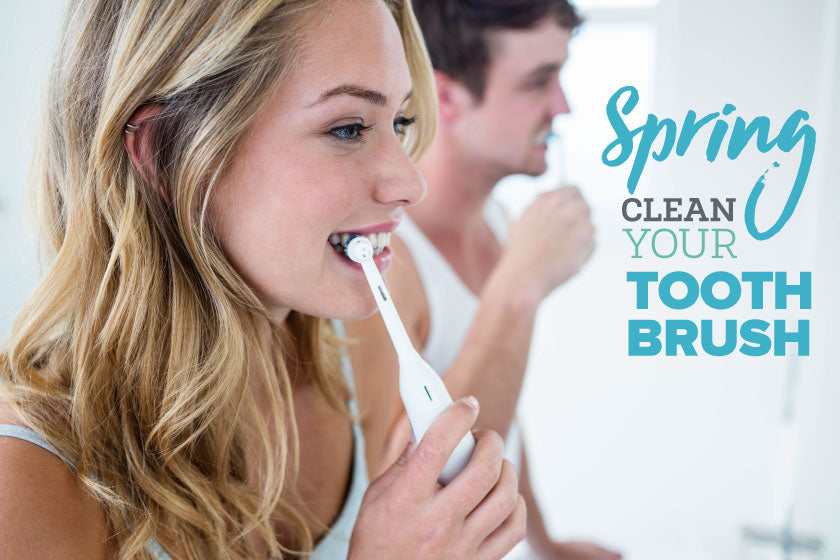Sometimes ignorance is bliss … especially when it comes to toothbrush germs.
If you think you can handle the truth, here it is: the average toothbrush contains more than 10 million bacteria, including E.coli and streptococcus, according to a 2012 study at the University of Manchester in England.
That’s more than the average toilet seat, which has 50 bacteria per square inch!
Before you get into total gross-out mode, know that some of these germs already exist in your mouth and you likely won’t get sick from your own toothbrush. The problem is when you share toothbrush space with others … that’s how “catchable” germs are spread.
With spring in the air, now’s the perfect time to “brush up” on some easy ways to disinfect your toothbrush and keep it clean each day.

3 Easy Ways to Disinfect Your Toothbrush
Does it ever seem like the minute you crack open a new toothbrush you seem to get sick? Rather than toss the new toothbrush, here are some ways you can quickly disinfect your toothbrush so you don’t get other people in your household sick.
Keep in mind, however, you eventually WILL have to replace your toothbrush. How often? The American Dental Association recommends every 3–4 months and sooner if the bristles are frayed. (Frayed bristles won’t remove plaque like they’re supposed to.)
1. Clean Your Toothbrush with Hydrogen Peroxide
Hydrogen peroxide – not just for boo-boos anymore! This staple in the medicine cabinet can be used to quickly disinfect your toothbrush. Just soak your toothbrush in a little bit of hydrogen peroxide for 5 minutes (an empty pill bottle works great for this), rinse off your brush in warm water, then let your toothbrush air-dry.
If you’re sick, do this hydrogen peroxide soak after each brushing to get rid of toothbrush germs. Otherwise, once a week is great for general toothbrush cleaning.
Pro Tip: don’t reuse the same hydrogen peroxide each time. It loses its effectiveness when exposed to light.
2. Break Out the Mouthwash
Soak your toothbrush head in mouthwash for 10 minutes, then rinse with hot water and let it air-dry. Easy peasy! If you don’t have mouthwash, you can follow the same process using rubbing alcohol to clean your toothbrush.
3. Use Boiling Water
This is a great way to get rid of an illness like strep from your toothbrush, which is highly contagious to other family members. Just boil some water and dip your toothbrush head into the boiling water for 5–10 seconds. Voilá! No more toothbrush germs!

Dos & Don’ts for a Clean Toothbrush
Do: Allow Your Toothbrush to Dry Upright
While it’s tempting to keep your toothbrush tucked away in a drawer, letting your toothbrush air-dry in an upright position is best for decreasing bacteria growth.
Do: Rinse Your Toothbrush Thoroughly After Each Use
Thoroughly rinse your brush with tap water after each brushing. This will ensure that any leftover food particles and toothpaste go bye-bye instead of hanging around in the bristles of your brush.
Do: Close the Lid
Science shows that aerosols from toilets (aka “poop particles”) do go airborne, landing on surfaces within the bathroom … including your toothbrush if it’s within 6 feet of the toilet. Simply closing the lid before you flush will solve this problem … yet, according to a Scrubbing Bubbles survey, only 60% of people are actually doing this!
Don’t: Use a Toothbrush Cover
Toothbrush covers create an ideal environment for bacteria to grow because it keeps the head of the toothbrush moist and doesn’t allow it to dry out in between uses.
Don’t: Share a Toothbrush
When it comes to tooth brushing, sharing isn’t caring. Just like your tummy, your mouth does need some “healthy” bacteria … but it needs to be your own.
Don’t: Allow Toothbrushes to Touch
Give each toothpaste some room to groove so that your family members aren’t spreading toothbrush germs.
Don’t: Waste Your Money on a UV Toothbrush Sanitizer
These pricey gadgets won’t remove all of the toothbrush germs and the ultraviolet light can deteriorate the bristles, decreasing the cleaning power of your toothbrush.

Eww. Don’t Forget to Clean This Germy Item …
Can you guess the germiest item in the entire bathroom? Nope, it’s not the faucets or even the toilet seat.
According to a 2011 study by NSF International, the humble toothbrush holder takes the title for germiest place in the bathroom. (“Germy” defined as containing levels of yeast, mold and coliform bacteria, which includes Salmonella and E.coli.)
In fact, out of 30 everyday household items tested in the study, the toothbrush holder ranked #3 germiest item, right after dish sponges and the kitchen sink.
Go ahead … peer inside your toothbrush holder if you dare. All that muck is really YUCK!
If your toothbrush holder is “cup-style,” that dark, closed-off area is even more susceptible to bacteria growth.
How to Clean Your Toothbrush Holder
- Soak your toothbrush holder in hot, soapy water for 10 minutes.
- Clean the outside of the holder with a soapy, clean cloth.
- Dump out the water and use a pipe cleaner or fine-bristled brush to get way down into the toothbrush holder to remove any hidden gunk.
- Fill the toothbrush holder with mouthwash and let it sit for 5 minutes. (If you don’t have mouthwash, use vinegar instead.)
- Rinse out the mouthwash and run the holder under water.
- Turn the toothbrush holder upside down on a clean towel to air-dry.
Ready … Set … Spring Clean!
Now that you know how easy it is to clean your toothbrush, it’s on to other spring cleaning chores. We’re curious: what is your favorite and least favorite spring cleaning chore? Share below!




